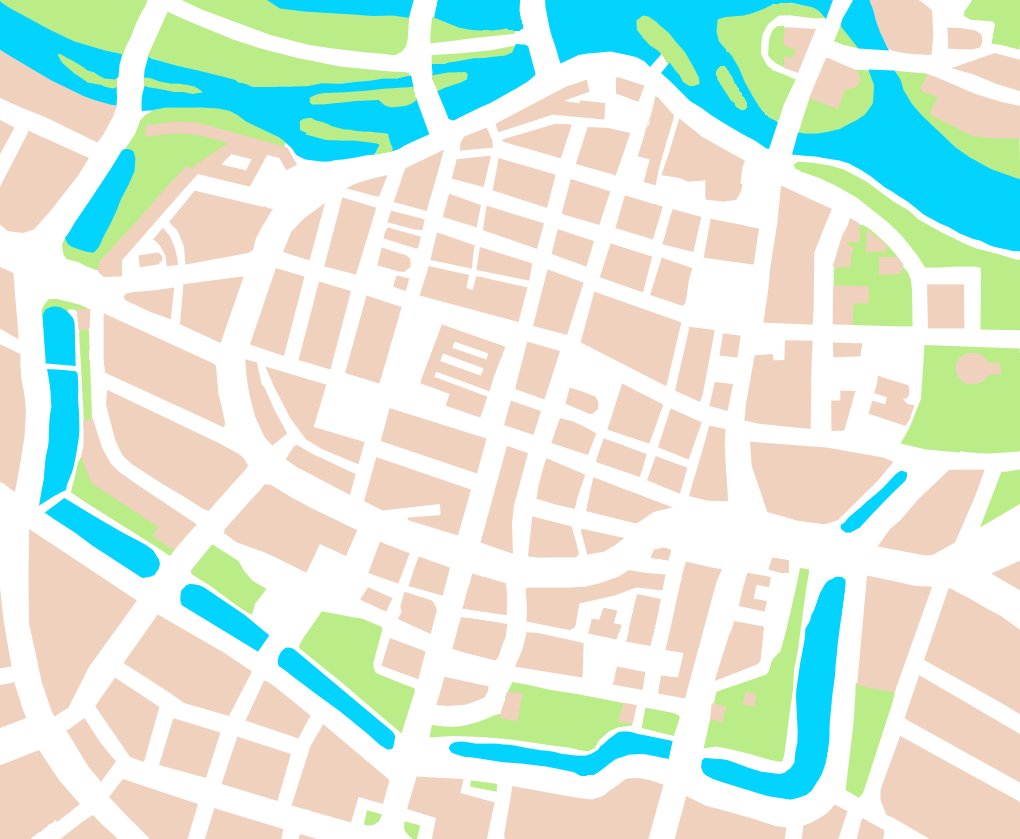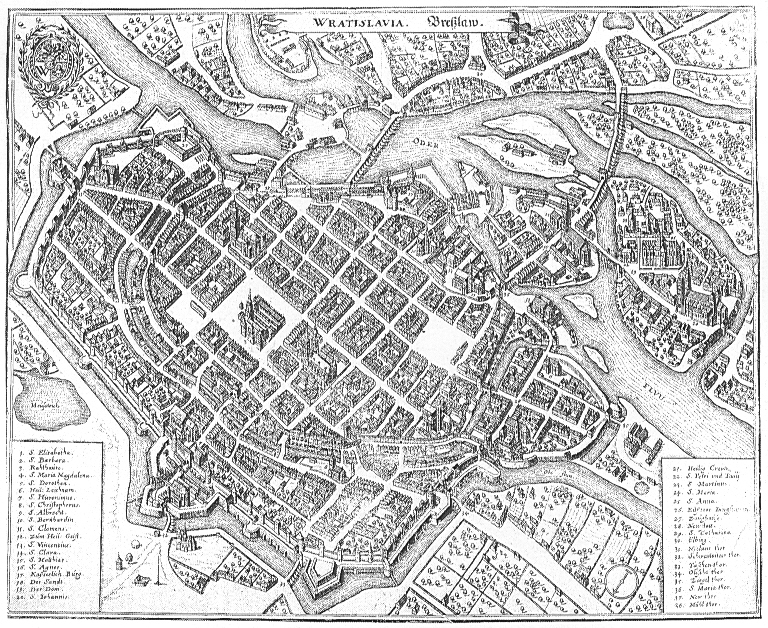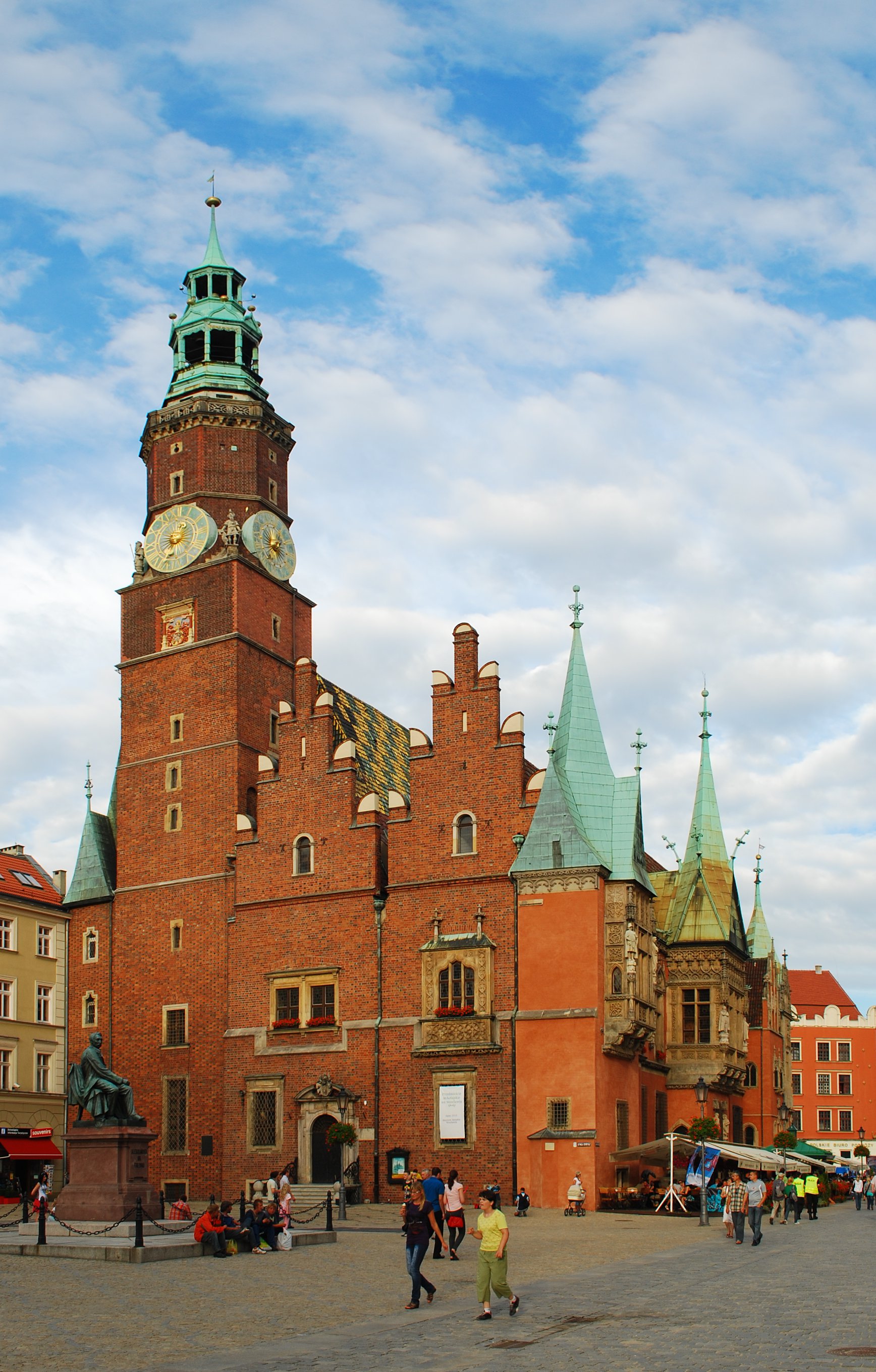Old Town, Wrocław on:
[Wikipedia]
[Google]
[Amazon]
The Old Town in
Wrocław
Wrocław (; german: Breslau, or . ; Silesian German: ''Brassel'') is a city in southwestern Poland and the largest city in the historical region of Silesia. It lies on the banks of the River Oder in the Silesian Lowlands of Central Europe, rou ...
( pl, Stare Miasto we Wrocławiu) is the oldest part of the left-bank Wrocław, originating from the thirteenth century. It is surrounded by the City Moat
A moat is a deep, broad ditch, either dry or filled with water, that is dug and surrounds a castle, fortification, building or town, historically to provide it with a preliminary line of defence. In some places moats evolved into more extensive ...
, a remnant of the complex system of fortifications, largely based on natural and artificial sections of the Oder River
The Oder ( , ; Czech, Lower Sorbian and ; ) is a river in Central Europe. It is Poland's second-longest river in total length and third-longest within its borders after the Vistula and Warta. The Oder rises in the Czech Republic and flows thr ...
and the Oława River flowing into it. The green belt
A green belt is a policy and land-use zone designation used in land-use planning to retain areas of largely undeveloped, wild, or agricultural land surrounding or neighboring urban areas. Similar concepts are greenways or green wedges, which hav ...
along the moat (and further along the Oder) is called the Old Town Promenade.
The center of the old city is the historic Market Square
The market square (or sometimes, the market place) is a Town square, square meant for trading, in which a market is held. It is an important feature of many towns and cities around the world.kamienice'', the  Old Town (''Stare Miasto'') is one of Poland's official national Historic Monuments (''
Old Town (''Stare Miasto'') is one of Poland's official national Historic Monuments (''
 In the 13th century, the town was under
In the 13th century, the town was under

File:St Maria Magdalena Church (202650167 cropped).jpeg, St Mary Magdalene Church
File:Wroclaw- Kosciol sw. Elzbiety.jpg, St Elizabeth's Church
File:Wroclaw-CorpusChristiChurch-164.JPG, Corpus Christi Church
File:6035vik Panorama Wrocławia z wieży Sky Tower. Foto Barbara Maliszewska.jpg, St Dorothea Church
* monastic complexes
** Cathedral of St. Vincent and St. James (Nankier Square), the Franciscans, later the Norbertans, now a Greek-Catholic cathedral
** Church of St. Clare and St. Hedwig (Nankiera Square), Poor Clares, later Ursuline
** St. Maciej Church (pl. Nankiera/Szewska), Hospitallers
** St. Agnes Church (Szewska), Hospitallers, destroyed
** Corpus Christi church (Świdnicka Street), St. John's Church
** Church of St. Stanislaus, St. Dorothea and St. Wenceslas (Świdnicka Street), Augustinian hermits, later Franciscans
** Church of St. Anthony (St. Anthony Street), Franciscans, then Elizabethans and then Salesians
** Church of the Name of Jesus (Uniwersytecki Square), Jesuits
** St. Catherine's Church (St. Catherine's Street), Dominican
File:Pl._Nankiera_16,_Wrocław_1.jpg, Saints Hedwig and Clare Church
File:SW_Maciej.jpg, Saint Maciej Church
File:Wroclaw ulSwAntoniego kosciol.jpg, Saint Anthony of Padua Church
File:University_Church,_Wrocław.jpg, University Church of the Blessed Name of Jesus
SM katedra greckokatolicka d kościół św Jakuba D 598665.jpg, Saint Vincent Church
File:Wrocław Palace 2009.jpg, Royal Palace, Wrocław
File:Synagoge zum Weißen Storch Fotografin Isabelle Knispel.jpg, White Stork Synagogue
File:Opera, Breslavia, Polonia, 2017-12-20, DD 23-25 HDR.jpg, Wrocław Opera
File:PL-Breslau-Markthalle-1.jpg, Wrocław Market Hall
File:Market Square in Wrocław, September 2022 05.jpg, Barasch Brothers' Department Store (first on the left)
File:Wrocław- Mała Iglica.JPG, Mała Iglica, commemorating repressed Jewish population
File:Wroclaw-sculpture-Amor-on-Pegasus.jpg, '' Cupid on the Pegasus'' sculpture
Wrocław - Pomnik Aleksandra Fredry we Wrocławiu.jpg, Aleksander Fredro Monument
File:Sw Maciej Jan Nepomucen.jpg, Statue of John of Nepomuk
File:Jatki Wrocławskie e83.jpg, Memorial to Slaughtered Animals
1951viki Uniwersytet Wrocławski - Gmach Główny z Szermierzem. Foto Barbara Maliszewska.jpg, Fencer sculpture next to the University main building
Satellite photograph of the Old Town from Google Maps
{{Wrocław Tourist attractions in Wrocław W Objects of cultural heritage in Poland
Old
Old or OLD may refer to:
Places
*Old, Baranya, Hungary
*Old, Northamptonshire, England
*Old Street station, a railway and tube station in London (station code OLD)
*OLD, IATA code for Old Town Municipal Airport and Seaplane Base, Old Town, Mai ...
and New Town Hall (''Ratusz''). There is a number of historic landmarks in its vicinity, such as the Salt Market, St. Elizabeth of Hungary Church, St. Mary Magdalene Church, and numerous monuments. In the northern part of the old town can be found the main campus of the Wrocław University
Wrocław (; german: Breslau, or . ; Silesian German: ''Brassel'') is a city in southwestern Poland and the largest city in the historical region of Silesia. It lies on the banks of the River Oder in the Silesian Lowlands of Central Europe, ro ...
with the University Square, and on the opposite, southern side, lies the famous Quarter of the Four Denominations. The Church of Saints Hedwig and Clara next to Nankiera Square is the mausoleum of many rulers
A ruler, sometimes called a rule, line gauge, or scale, is a device used in geometry and technical drawing, as well as the engineering and construction industries, to measure distances or draw straight lines.
Variants
Rulers have long ...
of Silesia
Silesia (, also , ) is a historical region of Central Europe that lies mostly within Poland, with small parts in the Czech Republic and Germany. Its area is approximately , and the population is estimated at around 8,000,000. Silesia is split ...
, including Henry III, Henry V Henry V may refer to:
People
* Henry V, Duke of Bavaria (died 1026)
* Henry V, Holy Roman Emperor (1081/86–1125)
* Henry V, Duke of Carinthia (died 1161)
* Henry V, Count Palatine of the Rhine (c. 1173–1227)
* Henry V, Count of Luxembourg (121 ...
, Henry VI, and Anne of Bohemia
Anne of Bohemia (11 May 1366 – 7 June 1394), also known as Anne of Luxembourg, was Queen of England as the first wife of King Richard II. A member of the House of Luxembourg, she was the eldest daughter of Charles IV, Holy Roman Emperor and ...
.
 Old Town (''Stare Miasto'') is one of Poland's official national Historic Monuments (''
Old Town (''Stare Miasto'') is one of Poland's official national Historic Monuments (''Pomnik historii
Historic Monument ( pl, pomnik historii) is one of several categories of objects of cultural heritage (in the singular, '' zabytek'') in Poland.
To be recognized as a Polish historic monument, an object must be declared such by the President o ...
''), as designated September 16, 1994 in the first round. Its listing is maintained by the National Heritage Board of Poland
The National Institute of Cultural Heritage of Poland ( pl, Narodowy Instytut Dziedzictwa NID) is a Polish governmental institution responsible for documenting cultural property and the intangible cultural heritage, as well as for supporting and ...
. The Old Town is part of the city's administrative district
Local government is a generic term for the lowest tiers of public administration within a particular sovereign state. This particular usage of the word government refers specifically to a level of administration that is both geographically-loca ...
which is also named "Stare Miasto," although it covers a wider area than the Old Town itself.
History
The oldest part of Wrocław is Ostrów Tumski, which has been inhabited at least since the 9th century (nowadays it is part of the Śródmieście district), and the accompanying estates on the right and left bank of theOder River
The Oder ( , ; Czech, Lower Sorbian and ; ) is a river in Central Europe. It is Poland's second-longest river in total length and third-longest within its borders after the Vistula and Warta. The Oder rises in the Czech Republic and flows thr ...
were soon established. Already in the 12th century, there was a market square on the left bank of the river (in the area of today's Market Hall
A market hall is a covered space or a building where food and other articles are sold from stalls by independent vendors. A market hall is a type of indoor market and is especially common in many European countries. A food hall, the most usual ...
and Nankier Square). The areas north of today's Nankier Square and Uniwersytecka Street belonged to the prince's domain and were not part of the later founding city. The Piast dukes settled Jews there, founded monasteries, and had their own manors.
 In the 13th century, the town was under
In the 13th century, the town was under Magdeburg Law
Magdeburg rights (german: Magdeburger Recht; also called Magdeburg Law) were a set of town privileges first developed by Otto I, Holy Roman Emperor (936–973) and based on the Flemish Law, which regulated the degree of internal autonomy within c ...
, and there are conflicting opinions of scientists about the order of spatial development of the town. Scarce information is provided by various records of foundations, consecrations of parish churches (St. Adalbert, St. Andrew
Andrew the Apostle ( grc-koi, Ἀνδρέᾱς, Andréās ; la, Andrēās ; , syc, ܐܰܢܕ݁ܪܶܐܘܳܣ, ʾAnd’reʾwās), also called Saint Andrew, was an apostle of Jesus according to the New Testament. He is the brother of Simon Peter ...
, and St. Lawrence
Saint Lawrence or Laurence ( la, Laurentius, lit. " laurelled"; 31 December AD 225 – 10 August 258) was one of the seven deacons of the city of Rome under Pope Sixtus II who were martyred in the persecution of the Christians that the Roma ...
), as well as archaeological excavations. The first locations were made during the reign of Henry the Bearded
Henry the Bearded ( pl, Henryk (Jędrzych) Brodaty, german: Heinrich der Bärtige; c. 1165/70 – 19 March 1238) was a Polish duke from the Piast dynasty.
He was Duke of Silesia at Wrocław from 1201, Duke of Kraków and High Duke of all Pola ...
, probably after 1212. Two settlements established on the orthogonal geometrical grid were created in this way: those called ''Skultetas'' in 1214 and ''Civitas Wratislaviensis'' (the City of Wroclaw) in 1226, and the Novum Forum (New Market) existing since around 1230. Probably the former occupied the area in the area of Piaskowa, St. Catherine, Wit Stwosz, and Latin streets (and thus around today's Nowy Targ), while the latter (despite the coincidence of names) was around the square known today as Rynek. The jurisdictional boundaries of the settlements were most probably determined by today's Szewska Street. Another hypothesis says that with the establishment of today's Market Square, the city was delimited within the Fosa River, which still exists today, and later it was temporarily reduced.
During the Mongolian invasion in 1241, the settlements were destroyed and rebuilt by re-location, joining them into one city and surrounding a defensive perimeter running in the line of today's Trasa W-Z. Probably the connection of the previously delimited towns caused a disturbance of the geometric grid between the Market Square and Nowy Targ. Already in 1261, the city was expanded to a new, external Fosa, and in 1263 an independent New City (''Nowe Miasto'') was established, incorporated into the main city in 1327.
Small extensions of the city area took place when the fortifications were extended. It was only in connection with the decision to demolish them in 1808 that Wrocław was extended beyond the Old and New Town.
During World War II, the Old and New Town was severely damaged. During the reconstruction, the emphasis was placed, for ideological reasons, on the preservation of objects from the Gothic era, i.e. from the times of the Piast rule. Many more damaged but newer buildings were demolished in order to obtain bricks. Apart from the Gothic churches, the reconstruction was first focused on the area of the Market Square, aiming to restore the state from the early 19th century.
Nowadays, both former towns have the status of the Old Town ''Osiedle
Osiedle (Polish plural: ''osiedla'', from German ''Ansiedlung'' meaning ''settlement'') is a term used in Poland to denote a designated subdivision or neighbourhood of a city or its dzielnica, or of a town, with its own council and executive. Lik ...
'', which also includes Ostrów Tumski and the complex of eastern Oder islands.
Important sites
Museums and theatres
Many renowned points of interest in the Old Town include numerous art galleries as well as departments of the City Museum such as theRoyal Palace
This is a list of royal palaces, sorted by continent.
Africa
* Abdin Palace, Cairo
* Al-Gawhara Palace, Cairo
* Koubbeh Palace, Cairo
* Tahra Palace, Cairo
* Menelik Palace
* Jubilee Palace
* Guenete Leul Palace
* Imperial Palace- Massa ...
, the Old Town Hall
Old or OLD may refer to:
Places
*Old, Baranya, Hungary
*Old, Northamptonshire, England
*Old Street station, a railway and tube station in London (station code OLD)
*OLD, IATA code for Old Town Municipal Airport and Seaplane Base, Old Town, Mai ...
, Henryk Tomaszewski Theatre Museum, as well as the Archaeological Museum in the Arsenal.
There are also: the Pharmacy Museum, Museum of Pan Tadeusz
''Pan Tadeusz'' (full title: ''Mister Thaddeus, or the Last Foray in Lithuania: A Nobility's Tale of the Years 1811–1812, in Twelve Books of Verse'') is an epic poem by the Polish poet, writer, translator and philosopher Adam Mickiewicz. The b ...
, Lubomirski Museum and Ossolineum
Ossoliński National Institute ( pl, Zakład Narodowy im. Ossolińskich, ZNiO), or the Ossolineum is a Polish cultural foundation, publishing house, archival institute and a research centre of national significance founded in 1817 in Lwów (now Lv ...
, Museum of Architecture, and Museum of the University of Wrocław. Two major theatres are also located there: the Wrocław Puppet Theater, and the most famous Wrocław Opera
The Wrocław Opera (Polish: ''Opera Wrocławska'') is an opera company and opera house in the Old Town of Wrocław, Poland. The opera house was opened in 1841 and up to 1945 was named after the city's then German name, Oper Breslau.
History
An ...
.

Churches
* parish churches and auxiliary city churches: ** St. Adalbert (until 1226), later Dominican monastery **St. Mary Magdalene
Mary Magdalene (sometimes called Mary of Magdala, or simply the Magdalene or the Madeleine) was a woman who, according to the four canonical gospels, traveled with Jesus as one of his followers and was a witness to his crucifixion and
resurre ...
, formerly St. Andrew, parish church, after 1526 Protestant, now a Polish Catholic cathedral, burial site of Henry II
** St. Elizabeth, formerly St. Lawrence, parish, after 1526 Protestant, now Catholic again
** St. Barbara, after 1526 Protestant, since 1963 Orthodox Cathedral
** St. Christopher's Church, after 1526 and now Protestant
Other sites
*residences **imperial castle, demolished **royal palace
This is a list of royal palaces, sorted by continent.
Africa
* Abdin Palace, Cairo
* Al-Gawhara Palace, Cairo
* Koubbeh Palace, Cairo
* Tahra Palace, Cairo
* Menelik Palace
* Jubilee Palace
* Guenete Leul Palace
* Imperial Palace- Massa ...
* White Stork Synagogue
The White Stork Synagogue ( pl, Synagoga Pod Białym Bocianem) is a nineteenth-century synagogue in Wrocław, Poland. Rededicated in 2010 after a decade-long renovation, it is the religious and cultural centre of the local Jewish community, under ...
* Wrocław Opera
The Wrocław Opera (Polish: ''Opera Wrocławska'') is an opera company and opera house in the Old Town of Wrocław, Poland. The opera house was opened in 1841 and up to 1945 was named after the city's then German name, Oper Breslau.
History
An ...
* University
A university () is an institution of higher (or tertiary) education and research which awards academic degrees in several academic disciplines. Universities typically offer both undergraduate and postgraduate programs. In the United States, t ...
with the Old Library
* Wrocław Market Hall
Wrocław Market Hall ( pl, Hala Targowa we Wrocławiu, german: Breslauer Markthalle) is a food hall in central Wrocław, Poland. Designed by Richard Plüddemann, it was built between 1906-08 as the ''Breslauer Markthalle Nr 1'', when the city was ...
* Barasch Brothers' Department Store
The Barasch Brothers' Department Store (german: Warenhaus Gebrüder Barasch) is the original name of a department store in Wrocław, Poland (then Breslau, Germany), located between the eastern side of the market square and the Ulica Szewska (germ ...
Monuments
See also
*History of Wrocław
Wrocław (German: ''Breslau)'' has long been the largest and culturally dominant city in Silesia, and is today the capital of Poland's Lower Silesian Voivodeship.
The history of Wrocław starts at a crossroads in Lower Silesia. It was one of the ...
* Nadodrze
References
External links
Satellite photograph of the Old Town from Google Maps
{{Wrocław Tourist attractions in Wrocław W Objects of cultural heritage in Poland